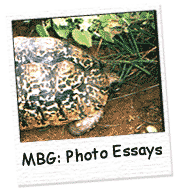 |
QUICK SEARCH
MO PROJECTS:
Africa
Asia/Pacific
Mesoamerica
North America
South America
General Taxonomy
Photo Essays
Training in Latin
America
MO RESEARCH:
Wm. L. Brown Center
Bryology
GIS
Graduate Studies
Research Experiences
for Undergraduates
Imaging Lab
Library
MBG Press
Publications
Climate Change
Catalog Fossil Plants
MO DATABASES:
W³MOST
Image Index
Rare Books
Angiosperm
Phylogeny
Res Botanica
All Databases
INFORMATION:
What's New?
People at MO
Visitor's Guide
Herbarium
Jobs & Fellowships
Symposium
Research Links
Site Map
Search
Introduction Introduction |
| Photo Essay Home | Begin Photo Essay | Outline | Photo Gallery | Search |

|
Images of Dry Tropical Habitat Images of Dry Tropical Habitat |
Contributor: Olson, Mark E.
This photo essay highlights some of the places Mark Olson traveled to while conducting research for his Ph.D.
When most of us in the US think of the tropics, we think of the tropical rain forest. It may come as a surprise that for over 75% of the tropics, annual drought is a way of life. There are many different kinds of tropical habitat that experience dry seasons, with names like tropical dry forest, tropical deciduous forest, thorn forest, spiny desert, savannah, cerrado, and caatinga. Some of these habitats aren't so unfamiliar after all: most people have seen images of giraffes, zebras, and elephants congregating around African waterholes during a dry season, with flat- topped Acacias or baobab trees adding a strange air to the landscape. Savannah scenes like these are often from the Serengeti, Masai Mara, or Tsavo parks in eastern Africa. These places, which definitely aren't rainforest, are right on the equator!
Dry tropical habitats are exciting places, rich in color and texture and full of strange organisms and surreal landscapes. This site is an attempt to share some of this excitement. The images on these pages aren't the only areas of tropical drylands. They are just from places I happen to have gone during my field work. Other important areas are underrepresented, like the vast tracts of cerrado and caatinga in Brazil, and the dry forests of southern Asia. Almost all of the areas shown on this web site are from hot lowlands, at elevations less than 1500 meters.
Despite being more extensive than rainforests, public awareness of tropical dry habitats is low and they receive little attention from conservation efforts. Dry areas of the tropics often have higher soil quality than tropical wet forest areas, making them better for agriculture. As a result, their degradation is far more advanced than that of wet forest. In addition, their contribution to humanity of such crops as maize -- the most important US crop -- is inestimable."
© 1995-2025 Missouri Botanical Garden, All Rights Reserved
4344 Shaw Blvd.
St. Louis, MO 63110
(314) 577-5100
Technical Support